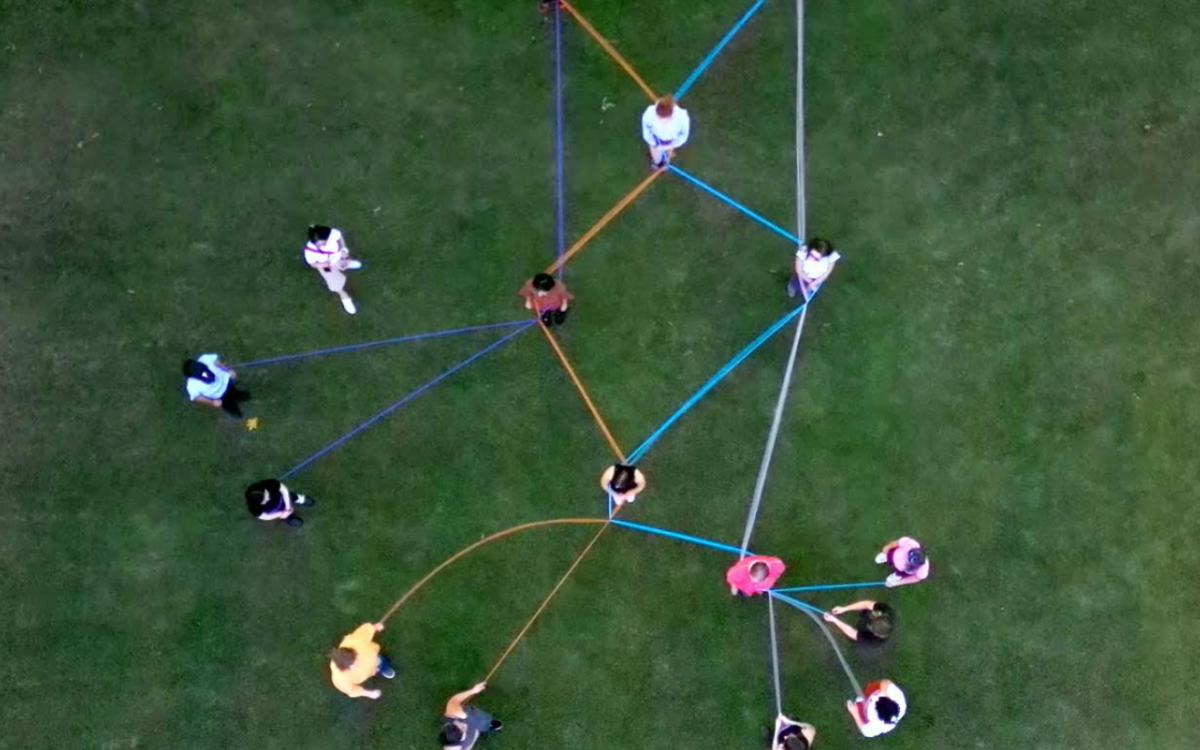At a glance
Ground Ensemble uses lace-making as a metaphor to explore social fabric, highlighting the connections and open spaces that… Read full summary
- Funding received
- 2023-2024
- Mini
- Awarded
- $5,000
- Funding partners
-
- Services and Activities Fee (SAF)
- UW Resilience Lab (UWRL)
- Website & social links
Ground Ensemble uses lace-making as a metaphor to explore social fabric, highlighting the connections and open spaces that shape collective belonging. Inspired by the flexible and intricate structure of lace, where threads interlace to form both design and void, students will trace their own "threads" and collaborate to create a unique social fabric. This project embraces the diversity of experiences and identities within a community, aligning with UW’s diversity goals by providing underrepresented students a space to reflect on shared histories, exchange perspectives, and build belonging. Participants will learn to balance individuality with interdependence, enhancing UW’s efforts to create inclusive environments for all identities.
Lace is an unstable textile featuring web-like thread structures and aesthetic open spaces. In bobbin lace, many threads wound on small wooden sticks (bobbins) are moved sequentially to create intricate patterns across a surface full of holes. Before lace, holes existed in the context of the structures of preexisting cloth. In the early 16th century, lace was developed in Europe as a laborious, additive process of “punto in aria”, Italian for “stitching in air”. In lace, both the holes and the lace design are made by strategic placement and tensioned movement of threads.
This level of profoundly freeform cloth making was the result of gradual technical innovation developed by generations of lacemakers who rarely could afford to embellish themselves with the lace they made. Marginalized by the established social fabric and excluded from uneven distribution of wealth, the artisans’ deep relationship with and appreciation of materiality motivated them to look for new ways to build and define holes and a new form of governing system of threads that were meaningful to them.
The structure of lace provides a new way to imagine the concept of social fabric, a metaphor for the relationship and connections individuals make with one another as common threads of a society. In Ground Ensemble, students will take time to understand and trace their own thread, then perform as autonomous lace bobbins that interlace to form their own foundational social fabric while defining open spaces that are important to them. Unlike woven cloth which has a rigid structure featuring a binary system and repetitive motion of over and under, the logic of
lace is incredibly flexible, allowing different forms of intersections and entanglement to take place simultaneously. No one exists outside this fabric, as each bobbin and pin plays a role in tension-keeping in order to govern the integrity of the cloth. Ground Ensemble will help increase UW’s capacity to create homes for diverse identities, experiences and perspectives. It is one of UW’s diversity blueprint goals to “serve students from communities that are underrepresented in higher education, including students who identify as Indigenous, Black, and People of Color; students from low- and modest-income families; students who identify as disabled, LGBTQ+, veterans, and alumni of foster care; international students; transfer students; and students who are part of recent immigrant populations.” Throughout the quarter, students may find Ground Ensemble a productive space where they
can meditate on ways they exchange pasts and presents to make space for collective belonging, now and beyond. Bound in the same social fabric, they will also learn to negotiate visibility, invisibility and shifting between states.
Led by graduate student Althea Rao, Ground Ensemble as a special topic course will be jointly offered by the following departments in collaborations with respective professors:
DXARTS: Afroditi Psarra, Tivon Rice
HCDE: Daniela Rosner
DRAMA: Jasmine Mahmoud
CHID: Philip Thurtle
Dance: Jen Salk
In addition, the Ensemble will be joined by Layla Klinger (Lecturer, The New School), who is a long time collaborator on this project and an expert of handmade lace.
We have identified the following topic areas throughout the quarter to develop theoretical
conversations as well as embodied activities around:
- Ensemble Building: Lineage Mapping and Introduction to Performance Geography Framework
- Ensemble Building: Mark Making, Critical Archive and Embodied Repertoire
- Structure: Textile, Social Fabric, The logic of Lace, Introduction to Bobbin Lace
- Structure: The Mathematical Model of Lace Ground, Lace as Pseudocode, Coding as Choreography
- Perspectives: Visioning Practices: Overhead Blueprint versus Ground Based Perspectives
- Perspectives: Algorithmic, Data Driven and Wearable Interfaces for Live Performance I
- Perspectives: Algorithmic, Data Driven and Wearable Interfaces for Live Performance II
- Embodiment: Soundscape and Choreography Score Development I: Closed Lab
- Embodiment: Soundscape and Choreography Score Development II: Closed Lab
- Embodiment: Soundscape and Choreography Score Development III: Open Lab
- Open Celebration (Time TBD, with presenting partners to be identified, possibly the Meany)
Althea Rao
Project lead
- althear@uw.edu
- Affiliation
- Student
- Years
- 3 year(s) remaining at UW
- Affiliated groups
- Digital Arts and Experimental Media and Science, Technology, and Society Studies
Afroditi Psarra
Research advisor
- apsarra@uw.edu
- Affiliation and department
- Digital Arts and Experimental Media
- Stakeholder approval form
Request amount and budget
n/a
Measure the impacts
Resilience and Compassion impact will be measured by student enrollment, engagement and attendance of enrolled students, student’s personal development and growth. In addition, Ground Ensemble will host an open celebration with the entire UW community in 2025 (time / presenting partner TBD) and we will record performance attendance as well. We will also provide physical opportunities for enrolled students and audience members to provide feedback as to contemporary issues and themes relevant to the work and the issues raised by the Ensemble.
We will also quantify the recycled textiles acquired for this project. We will evaluate our success by the proportion of repurposed, donated or recycled textile in the overall material, especially those pre-owned by students and are transformed into new artifacts through this performance.
